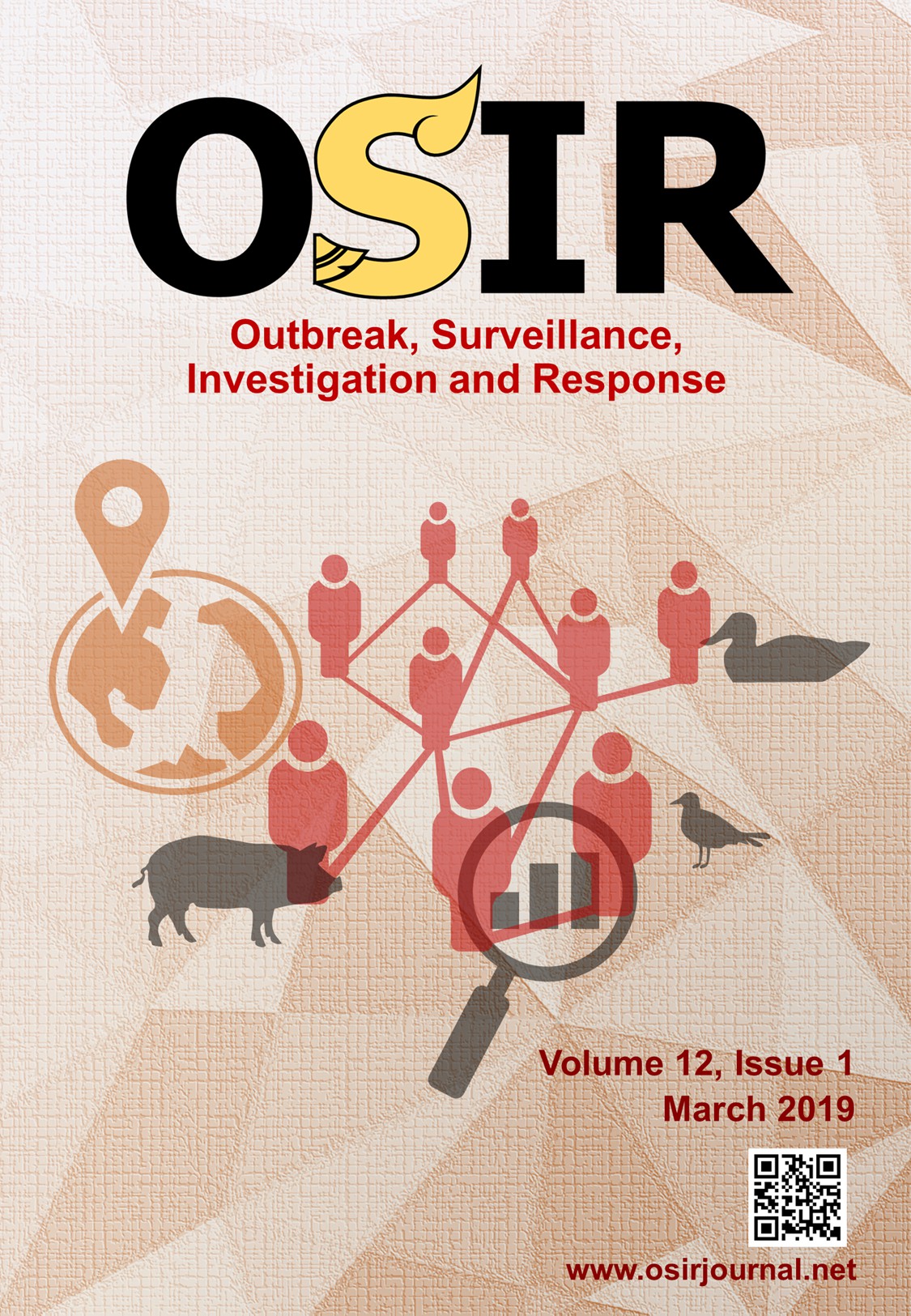Epidemiological Features of Japanese Encephalitis among Acute Encephalitis Syndrome Cases in Myanmar, 2014-2016: Implications to the Vaccination Program
DOI:
https://doi.org/10.59096/osir.v12i1.263021Keywords:
Japanese encephalitis, AES, vaccination, MyanmarAbstract
Japanese encephalitis (JE) was confirmed in Myanmar since 1974 and sporadic outbreaks have been reported. A descriptive study was conducted to determine the epidemiological characteristics of JE among acute encephalitis syndrome (AES) cases during 2014-2016 and identify potential risk factors for JE infection. The reported AES cases increased from 252 in 2014 to 1,911 in 2016. The annual proportion of JE among AES cases were 22.1-22.6% during 2014-2016. The highest proportion of JE among AES case was found in Rakhine State (44.6%) in 2016. Proportions of JE among AES cases were high in the rural areas, and in children aged 1-14 years. None of AES cases had previous JE vaccination prior to onset. JE infection was confirmed in 53.4% of serum and 47.0% of cerebrospinal fluid specimens obtained 3-7 days after onset of illness. In multivariate analysis, people aged one year and above, living in rural areas (Adjusted odds ratio = 2.9, 95% CI = 2.2-4.0) and having chickens and/or ducks in/nearby house (Adjusted odds ratio = 1.4, 95% CI = 1.0-1.9) were significantly associated with JE positivity among AES cases. An effective immunization campaign should be implemented nationwide, with prioritization given to the most affected areas and those aged 1-14 years.
References
World Health Organization. Meeting of the strategic advisory group of experts on immunization, October 2014 – conclusions and recommendations. Wkly Epidemiol Rec. 2014;89(50):561-76.
World Health Organization. A global brief on vector-borne diseases. Geneva: World Health Organization; 2014.
World Health Organization. Japanese encephalitis vaccines: WHO position paper, February 2015 – recommendations. Wkly Epidemiol Rec. 2015;90(9):69-88.
Ayu Mirah Adi AA, Astawa NM, Asri Damayanti PAA, Kardena IM, Krisna Erawan IGM, Suardana IW, et al. Seroepidemiological evidence for the presence of Japanese encephalitis virus infection in ducks, chickens, and pigs, Bali-Indonesia. Bali Medical Journal. 2016;5(3):533-7.
Campbell GL, Hills SL, Fischer M, Jacobson JA, Hoke CH, Hombach JM, et al. Estimated global incidence of Japanese encephalitis: a systematic review. Bull World Health Organ. 2011;89(10):766-74.
Myanmar. Central Epidemiology Unit. Department of Public Health. Ministry of Health and Sports. Acute encephalitis syndrome surveillance field guide. Nay Pyi Taw: Central Epidemiology Unit, Department of Public Health; 2016.
Saw-Lwin, Kyaw-Zeya. Epidemiology of Japanese encephalitis in Myanmar. Myanmar J Curr Med Pract. 1999;3:438-40.
Oo PM, Hlaing T,Lwin S, Pittyawonganon C, Sirichaisinthop J, Khine SK. A large outbreak of Japanese encephalitis in Rakhine State, Myanmar: implication for vaccine policy. OSIR 2016;9(2):8-15.
Khine SK, Swaddiwudhipong W, Tha KK, Aung TH, Naing NW, Than T, et al. Adult Japanese encephalitis outbreak following an immunization campaign in children, Shwe Pyi Tha Village, Sittwe Township, Rakhine State, Myanmar, 2016. OSIR 2018;11(1):1-5.
Myanmar. Ministry of Health. Health in Myanmar 2014. Nay Pyi Taw: Ministry of Health; 2014.
Myanmar. Vector Borne Disease Control Program. Department of Public Health. Ministry of Health and Sports. Annual report. Nay Pyi Taw: Vector Borne Disease Control Program, Department of Public Health; 2010.
Centers for Disease Control and Prevention. Epi Info. [cited 2018 Jan 22]. <http://wwwn.cdc.gov/epiinfo/html/prevVersion.htm>
Bandyopadhyay B, Bhattacharyya I, Adhikary S, Mondal S, Konar J, Dawar N, et al. Incidence of Japanese encephalitis among acute encephalitis syndrome cases in West Bengal – India. BioMed Research International volume 2013;896749.
Cleton NB, Bosco-Lauth A, Page MJ, Bowen RA. Age-related susceptibility to Japanese encephalitis virus in domestic ducklings and chicks. Am J Trop Med Hyg. 2014;90(2):242-6.
Bhattacharya S, Basu P. Japanese encephalitis virus (JEV) infection in different vertebrates and its epidemiological significance: a review. International Journal of Fauna and Biological Studies. 2014;1(6): 32-7.
Yin Z, Wang H, Yang J, Luo H, Li Y, Hadler SC, et al. Japanese encephalitis disease burden and clinical features of Japanese encephalitis in four cities in the People’s Republic of China. Am. J. Trop. Med. Hyg. 2010; 83(4):766-73.
Yen NT, Duffy MR, Hong NM, Hien NT, Fischer M, Hills SL. Surveillance for Japanese encephalitis in Vietnam, 1998–2007. Am J Trop Med. Hyg. 2010; 83(4):816-9.
Downloads
Published
How to Cite
Issue
Section
License
Copyright (c) 2023 Outbreak, Surveillance, Investigation & Response (OSIR) Journal

This work is licensed under a Creative Commons Attribution-NonCommercial-NoDerivatives 4.0 International License.








